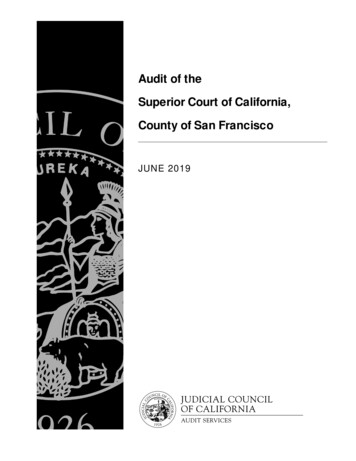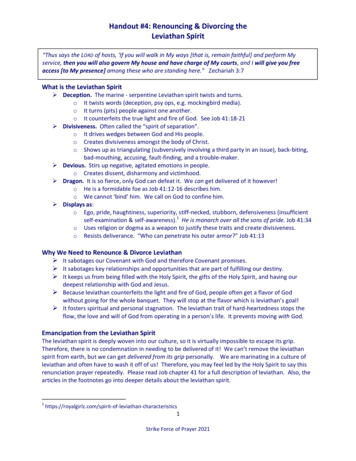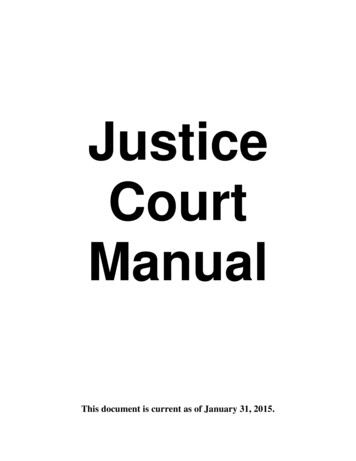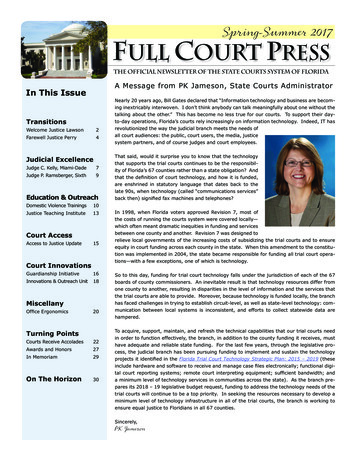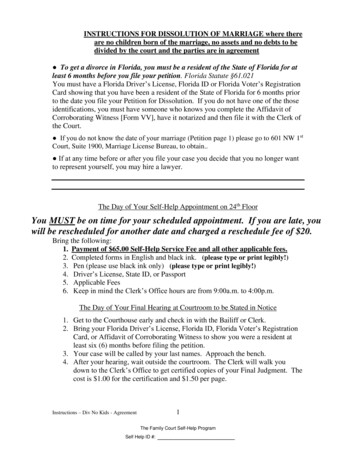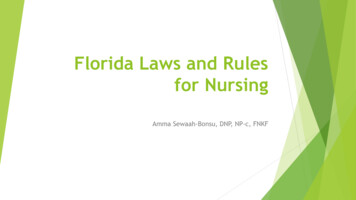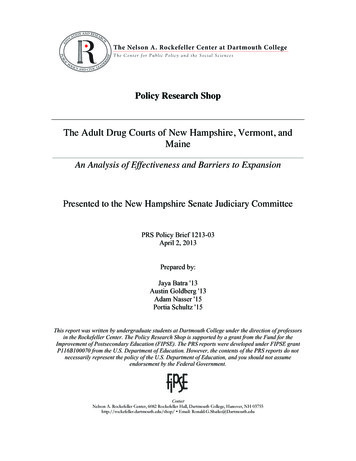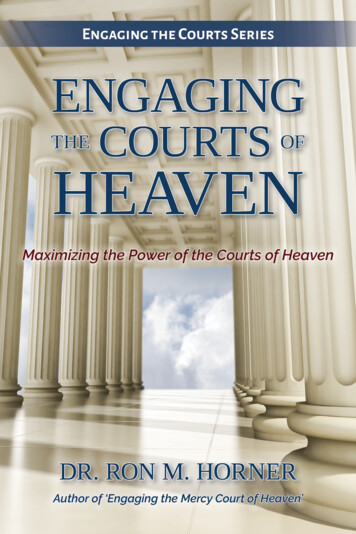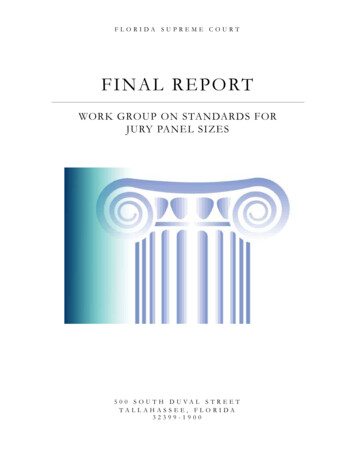
Transcription
FLORIDA SUPREME COURTF I N A L R E P O RTWORK GROUP ON STANDARDS FORJURY PANEL SIZES5 0 0 S O U T H D U VA L S T R E E TTALLAHASSEE, FLORIDA32399-1900
WORK GROUP ON STANDARDS FOR JURY PANEL SIZESTA B L E O F C O N T E N T STable of Contents1Members of the Work Group on Standards for Jury Panel Sizes2Acknowledgements3Chairman’s Remarks4Executive Summary5Summary of Recommendations7Section I: Guidelines for Jury Panel Sizes9Section II: Collaboration and Communication12Section III: Case Management and Complex Litigation13Section IV: Improvements in Summonsing Yield14Section V: Other Administrative Recommendations18Appendices19Final ReportPage 1
WORK GROUP ON STANDARDS FOR JURY PANEL SIZESM E M B E R S O F T H E WO R K G RO U P O N S TA N DA R D S F O R J U RY PA N E L S I Z E SThe Honorable Thomas Bateman III, ChairmanCircuit Judge, Second Judicial Circuit301 S. Monroe Street, Room 365-CTallahassee, Florida 32301The Honorable R. Fred Lewis, Supreme Court LiaisonJustice, Florida Supreme Court500 S. Duval StreetTallahassee, Florida 32399-1900Mr. Theodore Babbitt1450 Centrepark Boulevard, Suite 100West Palm Beach, Florida 33401-7404Mr. Gary M. Gregory3810 Braganza AvenueMiami, Florida 33133The Honorable James E. C. PerryChief Judge, Eighteenth JudicialCircuit301 N. Park AvenueSanford, Florida 32771-1292The Honorable John S. CarlinCircuit Judge, Twentieth JudicialCircuit1700 Monroe StreetFt. Myers, Florida 33901Mr. Benjamin H. Hill, IIIHill, Ward & Henderson101 E. Kennedy Boulevard, Suite3700P.O. Box 2231Tampa, Florida 33601-2231Mr. Eugene PettisHaliczer, Pettis & Schwann101 N.E. 3rd Avenue, 6th FloorFt. Lauderdale, Florida 33301-1160The Honorable Nancy DanielsPublic Defender, Second JudicialCircuit301 S. Monroe Street, Suite 401Tallahassee, Florida 32301The Honorable Jerry HillState Attorney, Tenth Judicial Circuit255 N. Broadway AvenueP. O. Box 9000 – Drawer SABartow, Florida 33831Mr. Neal Allan RothGrossman & Roth2665 S. Bayshore Drive, PH 1Miami, Florida 33133-5448The Honorable David A. DemersChief Judge, Sixth Judicial Circuit545 First Avenue NorthSt. Petersburg, Florida 33701The Honorable J. K. “Buddy” IrbyClerk of the Circuit Court, AlachuaCounty201 E. University AvenueGainesville, Florida 32602-0600Ms. Maria A. SantoroGeorge Hartz Lundeen et al.863 E. Park AvenueTallahassee, Florida 32301-2620The Honorable Edward H. FineChief Judge, Fifteenth Judicial CircuitNorth Dixie HighwayWest Palm Beach, Florida 33401The Honorable Thomas M. LynchCircuit, Seventeenth Judicial Circuit201 S.E. 6th Street, Room 930BFt. Lauderdale, Florida 33301Mr. Carl B. Schwait203 N.E. 1st StreetGainesville, Florida 32602Mr. Philip FreidinOne Biscayne Tower2 South Biscayne Boulevard, Suite3100Miami, Florida 33131The Honorable Robert R. MakemsonCircuit Judge, Nineteenth JudicialCircuit304 N.W. 2nd Street, Room 200Okeechobee, Florida 34972The Honorable Elijah SmileyCounty Judge, Bay CountyP. O. Box 2269Panama City, Florida 32404Ms. Faith Elizabeth GayWhite & CaseWachovia Financial Center, Suite4900200 South Biscayne BoulevardMiami, Florida 33131-2352Ms. Teresa McLellanDeputy Clerk of the Circuit Court,Escambia County190 Governmental CenterPensacola, Florida 32501Mr. Mark WeinbergTrial Court Administrator, SeventhJudicial Circuit125 E. Orange AvenueDaytona Beach, Florida 32114Final ReportPage 2
WORK GROUP ON STANDARDS FOR JURY PANEL SIZESA C K N OW L E D G E M E N T SSPECIAL ASSISTANCE PROVIDED BYThe Honorable Donald R. Moran, Jr.Chief Judge, Fourth Judicial CircuitThe Honorable Charles O. Mitchell, Jr.Circuit Judge, Fourth Judicial CircuitThe Honorable Gregory Mize (Retired)Center for Jury Studies at the National Centerfor State CourtsG. Thomas MunstermanCenter for Jury Studies at the National Centerfor State CourtsThe Eleventh Judicial Circuit Court of FloridaThe Ninth Judicial Circuit Court of FloridaThe Florida BarSTAFF TO THE WORK GROUPGregory YouchockChief of Court ServicesOffice of the State Courts Administrator500 S. Duval StreetTallahassee, Florida 32399-1900(850) 922-5108youchocg@flcourts.orgFinal ReportGregory CowanCourt Operations ConsultantOffice of the State Courts Administrator500 S. Duval StreetTallahassee, Florida 32399-1900(850) 922-5460cowang@flcourts.orgPage 3
WORK GROUP ON STANDARDS FOR JURY PANEL SIZESCHAIRMAN’S REMARKSIt is my honor and privilege to present the final report of the Work Group on Standards for JuryPanel Sizes (work group). It has been a pleasure to serve as the chairperson of the work groupthe past 18 months.Pursuant to Florida Supreme Court Administrative Order AOSC04-64, the work group reviewedthe history of the development of the current standards for jury panel sizes in Florida’s courts;reviewed a recently completed analysis conducted by the Office of the State Court Administrator(OSCA) on the applicability of the current standards; reviewed and considered the relationshipbetween jury panel size standards and the other indices utilized by Florida’s courts to determinethe efficient utilization of jury panels; and, reviewed the recommendations of the JudicialManagement Council’s Jury Innovation Committee regarding enforcement of non-compliantjurors and the postponement of jurors.This report, and the recommendations contained within, are the result of the work of thededicated members of the work group following productive and informative meetings held in thesouthern, central and northern geographical areas of the state, a presentation by andcommunication with representatives of the National Center for State Courts, a public hearingand written communications from many individuals, all of which the membership digested anddiscussed at length. As a result, other issues which touch on jury panel sizes, such as effectiveand efficient case management techniques and establishment of a lengthy and complex trial fundto compensate jurors who must be away from their employment while serving, also surfaced.While these matters were outside the scope of the Chief Justice’s charge to the work group, theywere discussed at length and a recommendation has been made to study them further.The work group relied heavily on the materials, findings and recommendations of the JuryInnovation Committee. As a consequence of the work group’s findings regarding non-compliantjurors, and consistent with the recommendation of the Jury Innovation Committee, in earlyFebruary I had the opportunity to make a presentation titled, “Dealing with Reluctant Jurors” tothe chief judges and trial court administrators. Discussions regarding the specific referrals theSupreme Court made to the chief judges were also included in the presentation. Currently, I amworking with the chief judge of the Second Judicial Circuit to develop and implement anadministrative order which addresses jury management issues, specifically non-compliant andpostponed jurors, for consideration in all of Florida’s judicial circuits in an effort to raise thereporting yield of those jurors summoned for jury duty.On behalf of the members of the work group, I would like to thank Mr. G. ThomasMunsterman, Director, Center for Jury Studies, National Center for State Courts and JudgeGregory Mize, Washington D.C. (retired) for once again answering the call for assistance fromthe state of Florida. Their guidance, counsel and support were invaluable. Thanks also to OSCAstaff members, Gregory Cowan and Gregory Youchock, for their dedication and hard work.Without them, the work group could not have functioned as well as it did.Finally, I would like to thank the Supreme Court’s liaison, Justice R. Fred Lewis, who attendedevery meeting and hearing, and the individual members of the work group not only for theirdiligence and hard work but for their vision of what the Florida State Court’s jury trial systemshould be.Final ReportPage 4
WORK GROUP ON STANDARDS FOR JURY PANEL SIZESE X E C U T I V E S U M M A RYThe recommendations and proposed guidelines found in this report are intended to provide acourse of action for making specific improvements to the management of the Florida StateCourt’s jury system. The recommendations should be adopted by the chief justice as policy ofthe Florida Judicial Branch. A number of general recommendations for future consideration bythe chief justice and the other members of the Florida Supreme Court are also provided.The current standards for jury panel sizes were established through administrative order issuedby Chief Justice Stephen H. Grimes on March 22, 1995. The standards, still in use today, andother provisions of the 1995 order are in need of change. These changes are due to a number offactors. They include the change in the juror source list from voter registration to the driverlicense and identification card list, the reported difficulty in empanelling a jury in certain types ofcriminal cases, as well as in complex or lengthy civil trials.It is clear that collaboration and communication among all relevant persons associated with themanagement of litigation cases and juries is imperative. No other factor is as important toensure an ample supply of jurors is available at the courthouse when needed for a jury trial. Atthe same time, collaboration and communication among all involved ensures that no citizen juroris unnecessarily inconvenienced by having to report to the courthouse when the juror is notneeded.Issues regarding case management and complex litigation came to light at the public hearing andwere prominent topics in work group discussions. The work group discussed and heardtestimony about the difficulty of getting complex cases to trial. While the issues were outside itsscope and purpose, the work group is convinced that there should be a further study made todetermine whether a process should be established which alleviates this problem.The work group recommends that a case management procedure be established for complexlitigation if further study demonstrates the need.The procedure should address the importance of setting a trial date early in the life of a case as ameans to expedite final disposition. The procedure should also address the importance of earlyand regular case management conferences between the court and counsel as the case proceeds.Any consideration of the complex litigation case management procedure should take intoconsideration the feasibility of establishment of a funding source for the management andoperation of a lengthy trial fund (LTF) to improve compensation to jurors who are required toserve on complex and lengthy jury trials.The need to increase the juror summoning yield was an issue generating extensive discussion atthe work group’s meetings. The work group recommends all available, reliable and up-to-dateinformation should be utilized to develop demographic information on eligible prospectivejurors statewide to increase the service of juror summonses and responses. Also, measuresidentified by the Jury Innovations Committee for juror summons enforcement were discussedand approved. It is recommended that the Florida State Courts initiate and aggressivelyimplement those measures. Toward this end, with assistance from the National Center for StateCourts, the chairman of the work group made a presentation on “Dealing with Reluctant Jurors”to the chief judges and trial court administrators at their February 2006 business meeting andeducational program in Tallahassee, Florida. Moreover, juror appreciation activities wereFinal ReportPage 5
WORK GROUP ON STANDARDS FOR JURY PANEL SIZESinitiated in many judicial circuits in 2005. The work group recommends that the activitiesinitiated in 2005 be expanded in future years with the express goal of improving jurorsummoning yield and increasing citizen participation in the jury process. In addition, it isrecommended that an ongoing effort be made to correct errors in the driver license source list toensure the reliability of the data for every potential juror.The final report from the Jury Innovations Committee completed in May 2001 provides a moreextensive list of recommendations and guidelines relating to juror management andadministration, in-court procedures, and juror treatment and compensation. Where applicable tothe more limited scope of the efforts of this work group, recommendations of the JuryInnovations Committee are cited.Final ReportPage 6
WORK GROUP ON STANDARDS FOR JURY PANEL SIZESS U M M A RY O F R E C O M M E N DA T I O N SI.GUIDELINES FOR JURY PANEL SIZESA. The chief justice should enter a new administrative order to govern themanagement of Florida’s jury system and to establish new guidelines for jurypanel sizes. This new order should replace the existing order entered on March22, 1995, by Chief Justice Stephen H. Grimes.B. Jury managers should ensure they are utilizing the new guidelines consistentwith directions provided in this report as well as the directions contained in theJury Management Manual to determine the maximum number of jurors that maybe needed to serve on a given date.II. COLLABORATION AND COMMUNICATIONThe chief justice should stress in the new administrative order the importance ofcollaboration and communication between all relevant parties associated with themanagement of cases and jurors. Collaboration and communication is imperative toensure an ample supply of jurors is available at the courthouse when needed while atthe same time ensuring no citizen juror is unnecessarily inconvenienced by having toreport when not needed.III. CASE MANAGEMENT AND COMPLEX LITIGATIONThe chief justice should consider the establishment of a work group or committeeto review the issues and make recommendations to improve the management ofcomplex cases, especially criminal cases involving those in which the death penalty isbeing sought and complex or lengthy civil cases.The work group recommends that a case management procedure be established forcomplex litigation if further study demonstrates the need.The procedure should address the importance of setting a trial date early in the lifeof a case as a means to expedite final disposition. The procedure should alsoaddress the importance of conducting early and regular case managementconferences between the court and counsel as the case proceeds.Any consideration of the complex litigation case management procedure shouldtake into consideration the feasibility of establishment of a funding source for themanagement and operation of a lengthy trial fund (LTF) to improve compensationto jurors who are required to serve on complex and lengthy jury trials.IV. IMPROVEMENTS IN SUMMONING YIELDA. All available, reliable and up-to-date information should be utilized to developdemographic information on eligible prospective jurors. The most accurate andFinal ReportPage 7
WORK GROUP ON STANDARDS FOR JURY PANEL SIZESreliable information available should be incorporated or merged into the jurorsource list for use by the courts to improve juror summoning yield.1B. The chief justice should continue to stress to chief judges, presiding judges, trialcourt administrators and jury managers the need to initiate and aggressivelyimplement measures to improve the summoning yield throughout theirjurisdiction.C. The chief judges, presiding judges and jury managers should continue to strivetoward the goal of maximizing the efficient use of jurors reporting for service.D. The chief judges, presiding judges and jury managers should continue jurorappreciation efforts. The efforts should be designed toward the goal ofincreasing citizen participation in the jury process.E. The Governor and Legislature should implement the specific recommendationsmade by the Jury Innovations Committee to improve the driver license sourcelist.V. OTHER ADMINISTRATIVE RECOMMENDATIONSA. The chief justice should direct staff from the Office of the State CourtsAdministrator (OSCA) to implement changes to the Jury Management Report(JMR) form currently being utilized to capture the data necessary for measuringand evaluating the jury management operations throughout the state. Thechanges to the JMR form should be designed to ensure the data collected ismeaningful for the purpose of measuring and evaluating compliance with thenew guidelines for jury panel sizes.B. The chief justice should direct staff from the OSCA to provide technicalassistance to the trial courts as requested to assist in their efforts to implementthe recommendations included in this report.For example, see Garrahan, Mike. "Using Social Security Numbers to Maintain Your List." Jur-EBulletin (2005): 2-3. 30 Dec. 2005http://www.ncsconline.org/WC/Publications/KIS JurInnJurE12-02-05.pdf1Final ReportPage 8
WORK GROUP ON STANDARDS FOR JURY PANEL SIZESS E C T I O N I : G U I D E L I N E S F O R J U RY PA N E L S I Z E SThe importance of establishing a realistic yet meaningful set of performance measures for theFlorida State Court’s jury system can not be overemphasized. Such measures are particularlynecessary given the importance of maintaining for litigants an unfettered access to jurors and thejury process while recognizing fiscal limitations.The performance measure that has long been adopted in the Florida State Courts for thispurpose is jury panel sizes. However, the evidence gathered by the work group suggests that thecurrent standards for jury panel sizes used to measure performance have become outdated andunderutilized. Recommendations provided in this section are designed to correct this trend.RECOMMENDED NEW GUIDELINES FOR JURY PANEL SIZESIn its final report, the Jury Innovations Committee stated, “There is a direct relationship betweenstandard panel sizes and efficient juror use.” Both this statement and the two specific changes tothe panel sizes recommended by the Jury Innovations Committee are endorsed by the WorkGroup on Standards for Jury Panel Sizes. However, inaddition to the two specific changes recommended byRecommendation I-A: The chief justicethat committee, the work group also recommendsshould enter a new administrative orderadditional changes to the current panel size standards.to govern the management of Florida’sjury system and to establish newThe recommended changes are designed to achieve threeguidelines for jury panel sizes.goals:1. Ensure an ample supply of jurors is available at the courthouse the day of jury selection;2. Ensure no citizen is unduly inconvenienced by being unnecessarily summoned orrequired to report for jury duty; and3. Ensure the Florida State Courts are efficiently using the fiscal resources dedicated forthe payment of juror per diem.To achieve these goals, it is recommended the chief justice enter a new administrative order togovern the management of Florida’s jury system. This new order should replace the existingorder entered on March 22, 1995, by Chief Justice Stephen H. Grimes as well as thememorandum issued October 20, 2003, by Chief Justice Harry Lee Anstead.The new order should establish new “guidelines” for jury panel sizes. The table found inAppendix A outlines the specifics. In general, the changes incorporated into these newguidelines for jury panel sizes include:1. Allowance for the presiding judge to exempt complex and lengthy cases from the panelsize guidelines. Currently this authority is granted to the chief judge.2. Allowance for the presiding judge to deviate from the panel size guidelines for typicalcases in which there are additional criminal case defendants or civil case parties, forFinal ReportPage 9
WORK GROUP ON STANDARDS FOR JURY PANEL SIZESlengthy trials, for high profile trials, and for other extraordinary circumstances. No suchdeviations are presently available in the current standards.3. Expansion of the list of case types currently established in the March 22, 1995, order.This expansion will allow for larger panels for certain case types (e.g., sexual battery,child abuse cases) where impaneling a jury is more difficult.4. Incorporation of a number of upward adjustments to the current jury panel sizes due inpart to the impact of the change in the source list from voter registration to driver’slicense.In addition to these changes, the new administrative order should include general guidance forthe implementation of these new guidelines. The general guidance should include at a minimum:1. A statement expressing the new guidelines as a tool for presiding judges and jurymanagers to use as guidance for determining the number of prospective jurors tosummons. That is, the new guidelines are not to be used as a hard and fast rule forlimiting the number of jurors being sent to a courtroom for voir dire.2. A statement stressing the importance of the early determination in all cases by thepresiding judge and trial attorneys of the number of prospective jurors to summons forthe trial of the case. In addition, that prompt communication in all cases must be madeto jury managers of the number of prospective jurors to summons as well as when theywill be needed. Reports to the work group indicate this determination andcommunication is not being made in a timely fashion or is completely absent in somejurisdictions.3. A statement stressing the importance of collaboration and communication between allrelevant persons associated with the management of cases and jurors as the mostimportant factor in ensuring an ample supply of jurors is available at the courthouse theday of jury selection while eliminating or at least minimizing inconvenience to citizens bymaking them report when not needed. Again, reports to the work group indicate thatthis level of collaboration and communication is lacking or absent in some jurisdictions.DETERMINING THE NUMBER OF JURORS TO SUMMONS USING THE RECOMMENDEDNEW GUIDELINESThe new guidelines, if adopted, are provided specifically to assist jury managers in determiningthe number of jurors to summons. Additional guidance regarding this determination can befound in the Jury Management Manual published by OSCA.As described in the manual, the initial step in determining the number of jurors to summons is topredict the number of cases scheduled for trial that will actually need a panel on a scheduleddate. This number can be determined by the jury manager through collaboration andcommunication with the parties associated with the management of the case and based onhistoric data (e.g., the average number of trial starts per day for several months) and intangiblefactors (e.g., trends of presiding judges and/or attorneys).Also through collaboration and communication, the jury manager should determine if any of thecases predicted to need a panel of jurors has been determined by the presiding judge to beFinal ReportPage 10
WORK GROUP ON STANDARDS FOR JURY PANEL SIZESexempted from or will deviate from the panel size guidelines. The jury manager should seek outor be advised of the information well in advance of the issuance of the juror summons to thosepotential jurors required for the cases actually set for jury trial.For the remaining routine cases predicted to need a panel of jurors on a scheduled date, the jurymanagers should use the guidelines in the table provided in Appendix A for estimating thenumber of jurors required for those panels.By adding together the numbers of jurors required for cases determined by the presiding judge tobe exempted from or which will require deviation from the guidelines to the number of jurorsrequired for the remaining cases, the jury manager can determine the maximum number of jurorsneeded to serve on a given date.At this point, the jury manager will need to consider thesummoning yield for the jurisdiction. Summoning yieldis the actual number of jurors available to serve dividedby the total number of jurors summoned. For example,if 100 summonses were sent out and only 34 of thosejurors summoned were available to serve, the summoningyield would be 34 percent. Since summoning yield canvary from week to week or month to month, historicsummoning yield for the individual jurisdiction isrecommended.Recommendation I-B: Jury managersshould ensure they are utilizing thenew guidelines consistent withdirections providing in this report aswell as directions provided in the JuryManagement Manual to determine themaximum number of jurors that maybe needed to serve on a given date.By dividing the maximum number of jurors that may be needed to serve on a given date by thesummoning yield, the jury manager can estimate the maximum number of jurors to summons. Aflowchart and a worksheet further delineating this process are provided in Appendix B andAppendix C, respectfully.Additional information and guidance for determining the number of jurors to summons isprovided in section 2.0 of the Jury Management Manual, and additional information regarding thegeneral rationale for standard panel sizes is provided in section 4.16 of the Jury ManagementManual. Also, information and guidance regarding postponements and other issues andtechniques associated with effective and efficient jury management are provided throughout theJury Management Manual.Jury managers needing assistance with any of these jury management issues, with the calculationsdescribed in this report or with any data requests should contact OSCA staff. Staff contactinformation is provided on page 4 of this report.Final ReportPage 11
WORK GROUP ON STANDARDS FOR JURY PANEL SIZESSECTION II: COLLABORATION AND COMMUNICATIONCollaboration and communication between all parties associated with the management of casesand jurors are imperative to ensure an ample supply of jurors is available at the courthouse theday of jury selection. Collaboration and communication are also important to ensure that nocitizen is unnecessarily inconvenienced by having to report for jury service when not needed.Finally, collaboration and communication are imperative to ensure the Florida State Courts areefficiently using the fiscal resources dedicated for the payment of juror per diem.While these points are included in the previous section, they are worth repeating. No singlefactor is as important for a successful jury management system as the collaboration andcommunication between the presiding judge, trial attorneys, jury managers, judicialassistants, bailiffs, clerks, or other local staff members associated with the managementof jurors.As is stated in the previous section, it is recommended the newadministrative order include general guidance regarding the importanceof collaboration and communication in jury management. Generalguidance in the administrative order should include:Recommendation II: The chiefjustice should stress in the newadministrative order theimportance of collaboration andcommunication between allrelevant parties associated with themanagement of cases and jurors.1. A statement stressing the importance of the earlydetermination in all cases by the presiding judge and trialattorneys of the number of prospective jurors to summonsand prompt communication in all cases to jury managers of the number of prospectivejurors to summons. Reports indicate this determination and communication is notbeing made in a timely fashion or is completely absent in some jurisdictions.2. A statement stressing the importance of collaboration and communication between allparties associated with the management of cases and jurors as the most important factorin ensuring an ample supply of jurors are available at the courthouse the day of juryselection while minimizing any inconvenience to citizens by having them report whennot needed. Again, reports indicate that this level of collaboration and communicationis lacking or completely absent in some jurisdictions.The Jury Management Manual states that a good working relationship between all parties associatedwith the management of cases and jurors is “a necessary ingredient to a successful jurymanagement program.” And it advises that the first two basic steps for jury managers to followin order to ensure efficient and effective jury management are:1. Develop support of the judiciary; and2. Cultivate a contact person (e.g., the judges’ judicial assistant) with each judge who canprovide accurate information on pending trials.Building these working relationships, developing the support of the judiciary, and cultivatingcontact persons all require collaboration and communication. Too often jury selection isdelayed, cases are continued, or mistrials declared simply because of the lack of collaborationand communication between the parties. Delays, continuances, or mistrials due to a failure tocollaborate or share information are simply unacceptable.Final ReportPage 12
WORK GROUP ON STANDARDS FOR JURY PANEL SIZESS E C T I O N I I I : C A S E M A NA G E M E N T A N D C O M P L E X L I T I G A T I O NThe management of juries and the management of cases are inextricably related. Of particularinterest to the work group were issues related to the case management of complex litigation andthe development of recommendations to improve upon the timely disposition of those cases.Toward that end, the work group initiated a review of successful methods currently being used insome Florida jurisdictions for the timely disposition of complex cases. The review included theprocedures currently being employed in the Fourth and Eighth Judicial Circuits of the FloridaState Courts as well as those employed in the Florida Middle and Southern Federal DistrictCourts. A presentation by Chief Judge Donald R. Moran, Jr. and Circuit Judge Charles O.Mitchell, Jr., from the Fourth Judicial Circuit of Florida, helped further illuminate the complexityof the issue itself.Discussions also included a review of the lengthy trial fund (LTF). The LTF represents aninnovative mechanism to help defray the loss of salary to citizen jurors while serving on complexand time consuming jury trials. A properly designed LTF should also help expedite the juryselection process by increasing the number of citizens available to serve on complex and lengthyjury trials.While
Pensacola, Florida 32501 Mr. Mark Weinberg Trial Court Administrator, Seventh Judicial Circuit 125 E. Orange Avenue Daytona Beach, Florida 32114 . WORK GROUP ON STANDARDS FOR JURY PANEL SIZES Final Report Page 3 ACKNOWLEDGEMENTS SPECIAL ASSISTANCE PROVIDED BY The Honorable Donald R. Moran, Jr. Chief Judge, Fourth Judicial Circuit The Honorable Charles O. Mitchell, Jr. Circuit Judge, Fourth .

